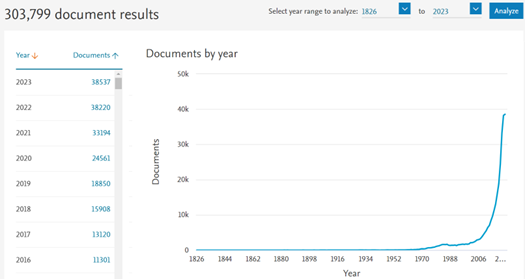Literature review: An effective method for identifying science and technology updates
Main Article Content
Abstract
Literature reviews have been proven to help researchers and scholars identify research gaps and identify potential new research paths. This shows an exponential increase in literature review articles from 2000 to the present. Therefore, this article introduces a special issue in MESI (Volume 3, Issue 3, 2023) dedicated to a literature review, highlighting five articles covering topics as diverse as plastic waste in road materials, porous hydroxyapatite for bone grafts, magnesium biocomposites, bio-based cutting fluids for manufacturing, contact mechanics perspective for medical therapy, and the concept, technology, and application of a swirl-type microbubble generator. These articles offer important insights into their respective fields, highlighting advances, challenges, and future research directions.
Downloads
Article Details

This work is licensed under a Creative Commons Attribution-NonCommercial 4.0 International License.
References
[2] M. J. Grant and A. Booth, “A typology of reviews: an analysis of 14 review types and associated methodologies,” Health Information & Libraries Journal, vol. 26, no. 2, pp. 91–108, Jun. 2009, doi: https://doi.org/10.1111/j.1471-1842.2009.00848.x.
[3] “Library Guides: Literature Review: Types of literature reviews,” Dec. 2016, [Online]. Available: https://libguides.csu.edu.au/review/Types.
[4] M. Setiyo, Teknik Menyusun Manuskrip dan Publikasi Ilmiah Internasional. Yogyakarta: Deepublish, 2017.
[5] M. Setiyo, D. Yuvenda, and O. D. Samuel, “The Concise Latest Report on the Advantages and Disadvantages of Pure Biodiesel (B100) on Engine Performance: Literature Review and Bibliometric Analysis,” Indonesian Journal of Science and Technology, vol. 6, no. 3, pp. 469–490, 2021, doi: https://doi.org/10.17509/ijost.v6i3.38430.
[6] P. S. Mahajan, R. Agrawal, and R. D. Raut, “State-of-the-art perspectives on data-driven sustainable supply chain: A bibliometric and network analysis approach,” Journal of Cleaner Production, vol. 430, p. 139727, 2023, doi: 10.1016/j.jclepro.2023.139727.
[7] Y. Yang, Z. Wei, and Z. Zhang, “Stakeholder Relationship in Construction Projects: A Mixed Methods Review,” Buildings, vol. 13, no. 12. 2023, doi: 10.3390/buildings13123122.
[8] A. Cimprich, K. Sadayappan, and S. B. Young, “Lightweighting electric vehicles: Scoping review of life cycle assessments,” Journal of Cleaner Production, vol. 433, p. 139692, 2023, doi: 10.1016/j.jclepro.2023.139692.
[9] D. I. Setyanansyach, M. Setiyo, and T. Raja, “Review and Bibliometric Analysis of Biogas Power Plants in Indonesia,” Advance Sustainable Science, Engineering and Technology (ASSET), vol. 5, no. 3, p. 2303015, 2023, doi: 10.26877/asset.v5i3.16806.
[10] B. V Venkatasubramanian and M. Panteli, “Power system resilience during 2001–2022: A bibliometric and correlation analysis,” Renewable and Sustainable Energy Reviews, vol. 188, p. 113862, 2023, doi: 10.1016/j.rser.2023.113862.
[11] M. Setiyo et al., “Industry 4.0: Challenges of Mechanical Engineering for Society and Industry,” Mechanical Engineering for Society and Industry, vol. 1, no. 1, pp. 3–6, 2021, doi: 10.31603/mesi.5309.
[12] M. Setiyo and M. L. Rochman, “The role of mechanical engineering in the era of industry 4.0 and society 5.0,” Mechanical Engineering for Society and Industry, vol. 3, no. 2, pp. 54–56, Dec. 2023, doi: 10.31603/mesi.10786.
[13] R. Widyorini, N. H. Sari, M. Setiyo, and G. Refiadi, “The Role of Composites for Sustainable Society and Industry,” Mechanical Engineering for Society and Industry, vol. 1, no. 2, pp. 48–53, 2021, doi: 10.31603/mesi.6188.
[14] A. Z. Ziva, Y. K. Suryana, Y. S. Kurniadianti, A. Bayu, D. Nandiyanto, and T. Kurniawan, “Recent Progress on the Production of Aluminum Oxide (Al2O3) Nanoparticles: A Review,” Mechanical Engineering for Society and Industry, pp. 54–77, 2021, doi: 10.31603/mesi.5493.
[15] F. B. Elehinafe, S. N. Ezekiel, O. B. Okedere, and O. O. Odunlami, “Cement industry–Associated emissions, environmental issues and measures for the control of the emissions,” Mechanical Engineering for Society and Industry, vol. 2, no. 1, pp. 17–25, 2022, doi: 10.31603/mesi.5622.
[16] M. Setiyo, “Alternative fuels for transportation sector in Indonesia,” Mechanical Engineering for Society and Industry, vol. 2, no. 1, pp. 1–6, 2022, doi: 10.31603/mesi.6850.
[17] S. M. N. Rahayu et al., “A Review of automotive green technology: Potential of butanol as biofuel in gasoline engine,” Mechanical Engineering for Society and Industry, vol. 2, no. 2, pp. 82–97, 2022, doi: 10.31603/mesi.7155.
[18] M. A. Ramly and M. Setiyo, “Carbon black: Production, properties, and utilization,” Mechanical Engineering for Society and Industry, vol. 3, no. 1, pp. 1–3, 2023, doi: 10.31603/mesi.8821.
[19] I. Veza et al., “Strategies to achieve controlled auto-ignition (CAI) combustion: A review,” Mechanical Engineering for Society and Industry, vol. 3, no. 1, pp. 22–34, 2023, doi: 10.31603/mesi.7568.

